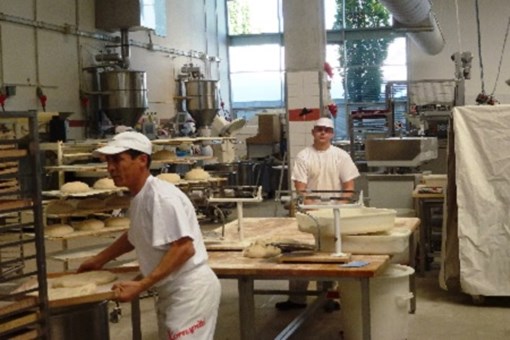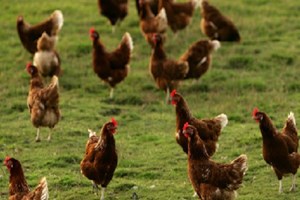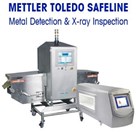 Bakers Are Benefitting From Sanitary Equipment Design
Bakers Are Benefitting From Sanitary Equipment Design
Throughout the food manufacturing industry, food safety is a top priority, and in order to enhance safety in their operations, baking companies are exploring sanitary equipment design solutions borrowed from the meat and poultry sectors.
FOOD SAFETY AND INSPECTION CASE STUDIES
-
Clean-In-Place (CIP) Recovery With Efficient Filtration9/26/2023
With the goal of lowering CIP process costs, a dairy producer and processor collaborated with Pall to implement a microfiltration solution, ultimately reducing operating costs and environmental footprint.
-
Hillshire Brands Uses Manufacturing Intelligence5/1/2023
Explore solutions utilized by the Jimmy Dean brand, part of the Hillshire Brands portfolio, to address weight variance in one-pound sausage rolls that was driving up product giveaway and lost revenue.
-
Increase Production Capacity With Virtualized Process Automation3/16/2023
Learn how Sleeman Breweries grew their production, improved process control, and avoided the high expense of building a new greenfield facility.
-
Full Sail Brewing Taps Manufacturing Intelligence To Enhance Process3/16/2023
Learn how a new filtration process helped Full Sail Brewing Company use water more efficiently while creating less waste and helping preserve a unique employee culture.
-
Solution Helps Chocolate Manufacturer Build A Streamlined Factory1/10/2021
Chocolates Valor S.A. produces high-quality chocolate bars, chocolates and snacks. The company invested in digitalization solutions for the production environment, in particular through Preactor APS, which is a family of products for production planning and programming that improves the synchronization of manufacturing processes and offers greater visibility and control. It showed an immediate return on investment.
-
Brand Spirits Leader Digitizes Business Operations With The SIMATIC IT Suite1/7/2021
Gruppo Campari closed 26 acquisitions in the spirits industry in the past two decades to become the world’s sixth player, with over 50 premium and super-premium brands. With each acquisition, Gruppo Campari needs to integrate new products, plants and assets into its operations management systems. By 2012 they realized there was no standard workflow for document authoring and validation, and information was shared via email or phone. Using Siemens technology, Gruppo Campari has created a unified repository for all product specifications and increased the efficiency of product development and manufacturing processes.
FOOD SAFETY AND INSPECTION ARTICLES
-
Addressing A Lack Of Transparency In Green Claims8/3/2023
The rise in consumer awareness and demand for greater transparency has led to changes in regulations worldwide. In response to greenwashing in the food sector, as well as other industries, regulatory authorities are stepping up efforts to hold organizations accountable for their green claims.
-
How Artificial Intelligence And Big Data Are Bolstering Food Safety4/18/2018
We're all familiar with China's past food safety issue with infant formula. But, past food safety events have taught many lessons for China, as well as the rest of the world. This article will detail some recent legislation that has led to advancements in food safety alerts, including liability insurance, and how artificial intelligence is helping shape the future of food safety.
-
What Can Be Done To Prevent Fraudulent Supply Chains?4/5/2018
Food fraud is a big topic at the moment and there are multiple challenges within any supply chain, especially these days where supply chains are global, have multiple players and where profits can be huge. In this column, I will detail some of the major obstacles in the organic food supply chain and show some practical applications which can reduce fraud within it.
-
Update Current Preventive Controls To Bolster Your Pest Control Programs3/26/2018
Spring has arrived, and while that means warmer days are ahead, it also means the return of the risk of pests to food manufacturing facilities. Rodents, birds, and insects are risks to food and can be sources of contamination by transmitting pathogenic bacteria, such as E. coli and Salmonella, to your products.
-
The ABCs Of An Allergen Control Plan3/6/2018
One way or another, most of us are subject to the statutory and regulatory provisions of FSMA. While some of these provisions are merely codifications of good manufacturing practices (GMPs), others are new and different requirements. Here, I discuss allergen control plans, why you need one, and some of the things that should be included within one.
-
GTINs, Barcodes, And Blockchain: What’s The Future Of Food Traceability?2/9/2018
Food manufacturers are working to improve traceability programs and minimize the impact of food recalls, driven in part by FSMA, cost savings, and brand protection. Boosted by the capabilities of today’s technology, such as Blockchain, the industry is moving closer than ever before to swift and precise recalls.
FOOD SAFETY AND INSPECTION
Food Safety
Food safety is a scientific discipline that deals with making food safe for consumption. It is a process involving the handling, preparation, processing and storage of food that prevents contamination and any food borne illnesses.
There are two considerations to food safety. The first is the safety of the manufactured product to the market and the second is the safety of the product from market to consumer. Food safety covers the entire food chain from raw ingredients to consumer consumption.
Safety considerations in food manufacturing include food hygiene, food additives, identification and removal of contaminants, import, export and domestic regulatory requirements, labeling, and certification systems.
There are five key principles of food hygiene. The first is to prevent food contamination with pathogens from people, pets and pests. The second is to keep process and store raw and cooked foods separately.
The third is cooking temperatures. Food should be cooked for the correct length of time at the right temperature to kill pathogens. The fourth principle is food storage temperatures. Foods should be stored at the proper temperature. The fifth principle depends on the availability of safe water in which to cook food.
Food safety is taken very seriously and the CDC uses a variety of surveillance systems to constantly monitor the occurrence of food borne diseases. Any outbreaks of food borne illnesses are immediately and thoroughly investigated.
Most food manufacturers must have a food safety plan in place in order to meet regulatory requirements. These programs assess food risks and have actions in place to prevent and manage risks. All actions are documented giving peace of mind to the business owner by protecting the business and the brand.
Food safety programs also assist in reducing food waste and improving productivity.
FOOD SAFETY AND INSPECTION NEWS
-
FSMA Update - FDA Announces Grant Award To Establish Regional Centers For Food Safety Training, Outreach And Technical Assistance2/19/2016
FDA Announces Grant Award to Establish Regional Centers for Food Safety Training, Outreach and Technical Assistance
- Key Technology Introduces Sanitary Rotary Finish On Vibratory Conveyors
- Obtain Guidance On Metal Detection’s Role In Food Safety
- JR Food Consultants Recommends Icicle HACCP Solution By Burton Software
- Loma Supplies IP69K Certified Inspection Equipment
- Seward Stomacher 400 Used To Ensure Poultry Is Safe For Consumption
- Plascon Group Acheives BRC Certification For Flexible Food Packaging
FOOD SAFETY & INSPECTION MULTIMEDIA
-
In this web chat, Samantha Cooper, manager of food safety and quality assurance at GMA, and Jon Samson, executive director of the Agricultural and Food Transporters Conference at the American Trucking Association, talk about FSMA’s Sanitary Transportation Rule. In addition to providing leading food safety practices, the 45-minute session focuses heavily on Samson and Cooper answering questions from the web chat’s live audience.
-
In this web chat, Jennifer McEntire, VP food safety & technology at United Fresh Produce Association joins Kristen Spotz, senior manager of food safety & quality assurance at GMA to talk all things traceability related to the food industry. In addition to providing leading traceability practices, the 45-minute session focuses heavily on McEntire and Spotz answering questions from the web chat’s audience.
FEATURED PRODUCTS
-
The RoughDeck™ HP High-Precision Low Profile Floor Scale features four NTEP-certified alloy steel, shear beam load cells, rugged diamond safety treadplate deck, rigid structural steel channel frame, and much more
-
METTLER TOLEDO SAFELINE is the world leader in customized metal detection and x-ray inspection solutions for food, pharmaceutical, and nutraceutical industries.
-
Food process controls provide the dependability and reliability that food testing laboratories need to meet the requirements of their quality assurance programs as well as to ensure the health of consumers. EZ-FPC™ enumerated lyophilized microorganism preparations are used as daily process controls for qualitative and quantitative detection methods.
-
Introducing the new FillTrac Fill Height Monitor. Incorporating 25 years of experience with the latest electronics, Filltrac makes it easy to provide your customers with properly filled containers.
-
In developing juice clarification solutions, we set out to address a variety of processing requirements. The result is our SUPER-COR modules, ingeniously designed in a series to maximize the ratio of membrane surface area to product volume, increasing juice throughput while minimizing energy usage.
-
Separation efficiency and performance reliability determines the separation device incorporated into system design. Schenck Process has a complete line of cyclones available for your intermediate storage and containment needs.
-
CIP 150® Alkaline Process and Research Cleaner is specially formulated to meet the unique cleaning demands found in biopharmaceutical manufacturing. The blend of alkalinity, surfactants, and oxidizing agents were developed for the most challenging protein-based process residues.
-
Do you actually know what happens in your suppliers’ operations and how the transport is arranged? Does the storage time of your products fall within the limits during every step of the preparation process?
























